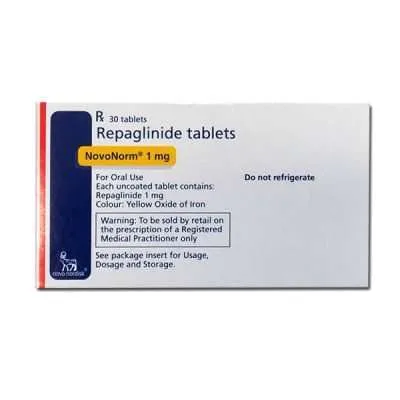Repaglinide (Generic)
$24.95
Repaglinide (Generic)
Repaglinide
Reasons to buy

WHAT IS REPAGLINIDE?
Repaglinide is an antidiabetic drug belonging to the meglitinide class. It is used in adjunct to diet and exercise for the treatment of type 2 diabetes mellitus (T2DM), specifically in those who are non-insulin dependent. It works by lowering blood glucose and preventing hyperglycemia. Controlling hyperglycemia prevents downstream complications such as kidney damage, loss of limbs, blindness, heart attack, stroke, or nerve problems. It is important to keep control over diabetes to decrease the chance of experiencing related complications. Repaglinide should not be used in those with type 1 diabetes mellitus (T1DM).
HOW DOES REPAGLINIDE WORK?
Repaglinide works by decreasing blood glucose levels in the blood. Repaglinide exerts this effect by initiating insulin production in the pancreas. This mechanism requires functioning (ß) cells in the pancreatic islets, and therefore repaglinide does not work in patients with T1DM. The production of insulin depends on glucose and results in decreased concentrations of glucose.
Repaglinide shuts ATP-dependent potassium channels within the membrane of ß-cells. Inhibition of these potassium channels depolarizes the ß-cell, causing calcium channels to open. Increased influx of calcium causes the release of insulin. This phenomenon is highly selective to ion channels in certain tissues, so skeletal and heart muscle are not affected.
SIDE EFFECTS
Common side effects include:
- Low blood sugar
- Respiratory infection
- Headache
- Sinus infection
- Joint pain
- Nausea
- Diarrhea
- Back pain
- Chest pain
- Constipation
- Vomiting
- Indigestion
- Weight gain
WARNINGS AND PRECAUTIONS
Hypoglycemia
As with all glucose-lowering drugs, repaglinide can cause hypoglycemia. To avoid hypoglycemia, use caution when initiating repaglinide, taking into account the patient, dose, and patient instructions. Specifically, those with hepatic, renal, adrenal, and pituitary insufficiency may have increased serum concentrations of repaglinide and are more likely to experience hypoglycemia. Additionally, patients who are elderly, debilitated, or malnourished may be more sensitive to hypoglycemic events. The elderly and those also on beta-blockers may have a more difficult time recognizing signs and symptoms of hypoglycemia. Hypoglycemia has a higher likelihood of occurring in the instance of extensive exercise, alcohol consumption, or when used with more than one glucose-lowering drug.
Macrovascular Outcomes
Decreased macrovascular risk with repaglinide or other antidiabetic drugs have not been proven in any clinical studies.
Hepatic Disease
A study with both healthy patients and patients with chronic liver disease (CLD) evaluated repaglinide. Those with liver function impairments had increased and prolonged concentrations of repaglinide in the blood. Therefore, those with hepatic impairment may have higher exposure to repaglinide and its metabolites compared to those with normal liver function. Consequently, repaglinide should be used with caution in those with hepatic dysfunction. Dose adjustments should be made such as lengthening the intervals between doses.
Uncontrolled Blood Glucose
If a diabetic patient controlled on an antidiabetic regimen experiences stress such as fever, infection, surgery, or trauma, they are at increased likelihood of losing glucose control. In these situations, it may be best to stop repaglinide and use insulin instead. Additionally, drugs that lower blood glucose may lose effectiveness over time, which is known as secondary failure. Before determining the patient is experiencing secondary failure, ensure their dose is adjusted appropriately and that they are adhering to a proper diet.
Renal Impairment
For those with mild renal impairment, an initial dose reduction is not necessary. However, in those with severe renal impairment, repaglinide should be initiated at a dose of 0.5 milligrams (mg) and titrated appropriately. Repaglinide has not been studied in those with a creatinine clearance of less than 20 mL/min or those needing hemodialysis.
DRUG INTERACTIONS
Various studies evaluated interactions between repaglinide and other drugs. Of note, there were no interactions between repaglinide and digoxin, warfarin, or theophylline. Additionally, concomitant use of cimetidine and repaglinide did not affect repaglinide absorption.
Gemfibrozil and Itraconazole
Concomitant use of gemfibrozil and repaglinide cause an 8.1-fold increase in repaglinide area under the curve (AUC) and an extended half-life. Concomitant use also resulted in an increased AUC. Concomitant use of both gemfibrozil, itraconazole, and repaglinide caused a 19-fold higher repaglinide AUC and a profoundly increased half-life. Patients taking gemfibrozil should not be administered repaglinide. Use caution when also taking itraconazole.
SPECIAL POPULATIONS
Pregnancy
Repaglinide did not elicit teratogenic effects in animal models, but these results are not always predictive of human response. Therefore, the safety of repaglinide is not fully established in pregnant women. However, uncontrolled glucose levels during pregnancy have been linked to congenital abnormalities. Therefore, only use repaglinide if truly needed, and consider insulin as an alternative.
Lactation
It is not known if repaglinide is excreted into human milk during lactation. Because of the hypoglycemia potential to nursing infants, providers should consider discontinuing repaglinide. If stopped, patients should maintain an adequate diet and be started on insulin therapy if needed.
Pediatrics
Repaglinide has not been evaluated in pediatric patients.
Geriatrics
Older adults may have greater sensitivity to repaglinide. Use caution when initiating in geriatric patients.
| Quantity | 0.5mg – 100 tab |
|---|
